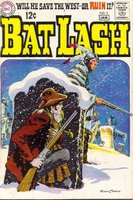
Back in the late 1960s and early 1970s. when I was assembling my collection, I picked up most of my early-mid 1960s DC from a friend of mine named Jon, and his neighbor, Eric. They had long runs of the comics they were interested in, but every now and then there was an issue or two missing. I don't have a clue as to why; perhaps they had just forgotten to go to the newsstand that month, or perhaps they had been broke, or perhaps they had just used the money for a new baseball mitt or something else.
This was one of the issues I never found, and since I wasn't fanatical about completing my Green Lantern run like I was about Batman, it was only a few years ago that I finally found a low-grade copy cheap enough to justify the purchase. IIRC, the first story was reprinted in the 1970s, but I don't think that cover story was until the relatively recent advent of the Archive and Showcase Editions.
The first story is The Shark that Hunted Human Prey. An accident in an atomic station on the coast led to a sudden emission of radiation that hit a passing shark:

Now of course, as far as the science goes, that's absurd. Evolution is a slow, torturous process with many missteps along the way. Still, it's in keeping with the science of comic books, in which Ben Grimm can turn into a pile of orange rocks (and occasionally turn back again).
The Shark discovers he has extraordinary powers, but he retains his essential nature:

After dropping the heavyweight champ without raising a fist, the Shark uses his awesome mental powers to locate a foe worthy of his abilities:

The Shark contacts Hal mentally and issues a challenge. Hal quickly changes into his fighting duds and recharges his ring in the locker room, but:

And for much of the battle that ensues, the Shark maintains his desire to induce fear in Green Lantern. He demonstrates that GL's ring has no power over him as he can block it with his mind. Indeed, his mental powers seem unlimited:

GL realizes that the air in the room is not colored yellow, so he stuns the Shark with a bolt of compressed air. But the Shark recovers and ups the stakes:

His intent was to make Hal afraid, but instead the threat just redoubles GL's resolve to win. He condenses the water vapor in the room and creates a block of ice with which to kayo the villain. Then he uses his power ring to devolve the Shark back into his normal state:

Comments: I found the concept of a shark evolved into a human somewhat ludicrous, and that costume is inane. However, that should not be allowed to obscure the fact that the character development was excellent and the story itself, with the threats to those Hal holds near and dear, is compelling.
The second story is the cover one, and it is pretty simple and straight-forward. While traveling through space, Hal encounters the planet, which suddenly forms a continent that looks like him. It shoots a rocket at him and one grazes him, forcing him to the ground. He encounters visions of Pieface, and several of his enemies. Finally the planet itself finds a way to contact him directly:

It was an intelligent planet who had searched the stars for more intelligence, and GL was the first it had ever encountered. It just wanted to make a friend, but couldn't find a way to express that at first. GL helps it by removing a volcanic core that was causing earthquakes, and they part as buddies.
Comments: Cute story, and the concept of a living planet would be "borrowed" a few years later by Stan Lee and Jack Kirby in the Mighty Thor series.
















































